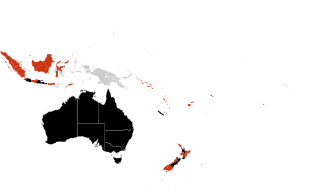
An agricultural show is a public event exhibiting the equipment, animals, sports and recreation associated with agriculture and animal husbandry. The largest comprise a livestock show, a trade fair, competitions, and entertainment. The work and practices of farmers, animal fanciers, cowboys, and zoologists may be displayed. The terms agricultural show and livestock show are synonymous with the North American terms county fair and state fair.

Swine influenza is an infection caused by any of several types of swine influenza viruses. Swine influenza virus (SIV) or swine-origin influenza virus (S-OIV) refers to any strain of the influenza family of viruses that is endemic in pigs. As of 2009, identified SIV strains include influenza C and the subtypes of influenza A known as H1N1, H1N2, H2N1, H3N1, H3N2, and H2N3.

Flu season is an annually recurring time period characterized by the prevalence of an outbreak of influenza (flu). The season occurs during the cold half of the year in each hemisphere. It takes approximately two days to show symptoms. Influenza activity can sometimes be predicted and even tracked geographically. While the beginning of major flu activity in each season varies by location, in any specific location these minor epidemics usually take about three weeks to reach its pinnacle, and another three weeks to significantly diminish.

In virology, influenza A virus subtype H1N1 (A/H1N1) is a subtype of influenza A virus. Major outbreaks of H1N1 strains in humans include the Spanish flu, the 1977 Russian flu pandemic and the 2009 swine flu pandemic. It is an orthomyxovirus that contains the glycoproteins hemagglutinin and neuraminidase. For this reason, they are described as H1N1, H1N2 etc., depending on the type of H or N antigens they express with metabolic synergy. Hemagglutinin causes red blood cells to clump together and binds the virus to the infected cell. Neuraminidase is a type of glycoside hydrolase enzyme which helps to move the virus particles through the infected cell and assist in budding from the host cells.

An influenza pandemic is an epidemic of an influenza virus that spreads across a large region and infects a large proportion of the population. There have been six major influenza epidemics in the last 140 years, with the 1918 flu pandemic being the most severe; this is estimated to have been responsible for the deaths of 50–100 million people. The most recent, the 2009 swine flu pandemic, resulted in under 300,000 deaths and is considered relatively mild. These pandemics occur irregularly.

Influenza A virus subtype H3N2 (A/H3N2) is a subtype of viruses that causes influenza (flu). H3N2 viruses can infect birds and mammals. In birds, humans, and pigs, the virus has mutated into many strains. In years in which H3N2 is the predominant strain, there are more hospitalizations.

As of 31 December 2016, Turkish population is 79,814,871 of which 23.7% are between 0-14, 68% are between 15-64 and 8.3% are older than 65 years old. Life expectancy at birth for men is 75.3 and for women is 80.7 years. Maternal mortality ratio has decreased from 23 to 16 per 100,000 live births between the years 2010 to 2015. According to the data from 2015, Under-five mortality and infant mortality rates per 1000 live births are 13.5 and 11.6.

The 2009 swine flu pandemic, caused by the H1N1 influenza virus and declared by the World Health Organization (WHO) from June 2009 to August 2010, is the third recent flu pandemic involving the H1N1 virus. The first two cases were discovered independently in the United States in April 2009. The virus appeared to be a new strain of H1N1 that resulted from a previous triple reassortment of bird, swine, and human flu viruses which further combined with a Eurasian pig flu virus, leading to the term "swine flu".
The 2009 flu pandemic in the United States was caused by a novel strain of the Influenza A/H1N1 virus, commonly referred to as "swine flu", that was first detected on 15 April 2009. While the 2009 H1N1 virus strain was commonly referred to as "swine flu", there is no evidence that it is endemic to pigs or of transmission from pigs to people; instead, the virus spreads from person to person. On April 25, the World Health Organization declared a public health emergency, followed concurringly by the Obama administration on April 26.

This article covers the chronology of the 2009 novel influenza A (H1N1) pandemic. Flag icons denote the first announcements of confirmed cases by the respective nation-states, their first deaths, and relevant sessions and announcements of the World Health Organization (WHO), the European Union , and the U.S. Centers for Disease Control (CDC).
In March and April 2009, an outbreak of a new strain of influenza commonly referred to as "swine flu" infected many people in Mexico and other parts of the world, causing illness ranging from mild to severe. Initial reports suggested that the outbreak had started in February due to farming practices at a pig farm half-owned by Smithfield Foods. Smithfield Foods stated that it had found no clinical signs or symptoms of the presence of swine influenza in the company's swine herd, or among its employees at its joint ventures in Mexico, that it routinely administers influenza virus vaccination to their swine herds and that it conducts monthly testing for the presence of swine influenza. The new strain was identified as a combination of several different strains of Influenzavirus A, subtype H1N1, including separate strains of this subtype circulating in humans and in pigs. The World Health Organization (WHO) and the U.S. Centers for Disease Control and Prevention (CDC) have expressed serious concerns that the new strain, which transmits between humans and has had a relatively high mortality rate in the possible and confirmed Mexican cases, has the potential to become an influenza pandemic. It is reported that, because the virus is already widespread, containment will be impossible.

The 2009 flu pandemic was a global outbreak of a new strain of influenza A virus subtype H1N1, first identified in April 2009, termed Pandemic H1N1/09 virus by the World Health Organization (WHO) and colloquially called swine flu. The outbreak was first observed in Mexico, and quickly spread globally. On 11 June 2009, the WHO declared the outbreak to be a pandemic. The overwhelming majority of patients experienced mild symptoms, but some persons were in higher risk groups, such as those with asthma, diabetes, obesity, heart disease, who were pregnant or had a weakened immune system. In the rare severe cases, around 3–5 days after symptoms manifest, the sufferer's condition declines quickly, often to the point of respiratory failure.

The pandemic H1N1/09 virus is a swine origin influenza A virus subtype H1N1 strain that was responsible for the 2009 swine flu pandemic. This strain is often called swine flu by the public media. For other names, see the Nomenclature section below.

The 2009 flu pandemic in Asia, part of an epidemic in 2009 of a new strain of influenza A virus subtype H1N1 causing what has been commonly called swine flu, afflicted at least 394,133 people in Asia with 2,137 confirmed deaths: there were 1,035 deaths confirmed in India, 737 deaths in China, 415 deaths in Turkey, 192 deaths in Thailand, and 170 deaths in South Korea. Among the Asian countries, South Korea had the most confirmed cases, followed by China, Hong Kong, and Thailand.

The 2009 swine flu pandemic in North America, part of a pandemic in 2009 of a new strain of influenza A virus subtype H1N1 causing what has been commonly called swine flu, began in the United States or Mexico.

The 2009 flu pandemic in Oceania, part of an epidemic in 2009 of a new strain of influenza A virus subtype H1N1 causing what has been commonly called swine flu, has afflicted at over 22,000 people in Oceania, with 56 confirmed deaths. Almost all of the cases in Oceania have been in Australia, where the majority of cases have resulted from internal community spread of the virus. In addition, the government of New Zealand, where most of the remainder of cases in Oceania have occurred, is on high alert for any people travelling into the country with flu-like symptoms.

The 2009 swine flu pandemic vaccines were influenza vaccines developed to protect against the pandemic H1N1/09 virus. These vaccines either contained inactivated (killed) influenza virus, or weakened live virus that could not cause influenza. The killed virus was injected, while the live virus was given as a nasal spray. Both these types of vaccine were produced by growing the virus in chicken eggs. Around three billion doses were produced, with delivery in November 2009.
The United States experienced the beginnings of a pandemic of a novel strain of the influenza A/H1N1 virus, commonly referred to as "swine flu", in the spring of 2009. The earliest reported cases in the US began appearing in late March 2009 in California, then spreading to infect people in Texas, New York, and other states by mid-April. Early cases were associated with recent travel to Mexico; many were students who had traveled to Mexico for Spring Break. This spread continued across the country's population and by the end of May there were approximately 0 confirmed cases throughout all 50 states.
The 2009 flu pandemic was a global outbreak of a new strain of influenza A virus subtype H1N1, first identified in April 2009, termed Pandemic H1N1/09 virus by the World Health Organization (WHO) and colloquially called swine flu. The outbreak was first observed in Mexico, and quickly spread globally. On the 11th of June 2009, the WHO declared the outbreak to be a pandemic. The overwhelming majority of patients experience mild symptoms, but some persons are at higher risk of suffering more serious effects; such as those with asthma, diabetes, obesity, heart disease, or those who are pregnant or have a weakened immune system. In the rare severe cases, around 3–5 days after symptoms manifest, the sufferer's condition declines quickly, often to the point respiratory failure. Although Ukraine was not (very) affected at first there was on outbreak of the virus in Western Ukraine in early November 2009 that led to the closing of public buildings and cancellation of meetings for three weeks.

The 1977 Russian flu was an influenza pandemic that was first reported by the Soviet Union in 1977 and lasted until 1979. The outbreak in northern China started in May 1977, slightly earlier than that in the Soviet Union. The pandemic mostly affected population younger than 25 or 26 years of age, and resulted in approximately 700,000 deaths worldwide. It was caused by an H1N1 flu strain which highly resembled a virus strain circulating worldwide from 1946 to 1957. Genetic analysis and several unusual characteristics of the 1977 Russian flu have prompted many researchers to say that the virus was released to the public through a laboratory accident, or resulted from a live-vaccine trial escape.











